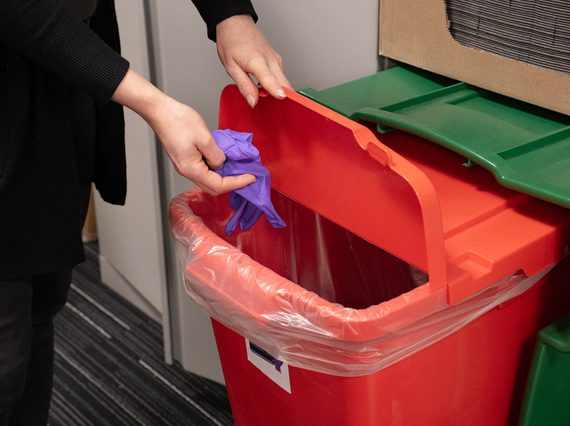
Tips for sustainable collections care
Find out how to develop more environmentally sustainable practices in collections care.
National Museums Scotland and the National Galleries of Scotland are reducing waste and carbon emissions in the care and conservation of their collections.
We share examples of experiments and successful improvements, along with a list of useful resources.
If you want to learn more about how our organisations are addressing the climate crisis, explore National Museums Scotland’s Strategy for Sustainability and the National Galleries of Scotland’s Environmental Response Plan.
Last updated: 17 July 2025
On this page
1. Measure carbon emissions
Caring for a collection can use a lot of energy and resources. The importance of improving environmental sustainability in collections care is recognised across the sector, nationally and internationally.
At National Museums Scotland and the National Galleries of Scotland, we’re measuring our carbon emissions, to identify where we can reduce emissions and track our progress.
Energy emissions
Like most museums and galleries, providing the appropriate temperature and relative humidity for our collection is a major source of energy consumption. We monitor this using the data from our gas and electricity meters.
Sometimes different parts of our buildings are not metered separately. This means we have to estimate the proportion of energy used in different collections spaces. At the National Galleries of Scotland we use the floor areas of the different zones to estimate this split.
Materials emissions
To count the carbon emissions of collections care and conservation materials, we often use the STiCH (Sustainability Tools in Cultural Heritage) carbon calculator.
The calculator automatically calculates emissions for commonly used care and conservation products. This helps cultural heritage professionals make informed choices to lower the environmental impact of their work.
Transport emissions
Transportation of our collections can generate a large carbon footprint, particularly if collections are loaned outside the UK.
At National Museums Scotland and the National Galleries of Scotland we’re trying different tools to calculate our transport emissions, including:
- Gallery Climate Commission Carbon Calculator (endorsed by the UK Registrars Group)
- UK Government Conversion Factors for greenhouse gas reporting
2. Reuse and recycle materials
Whether we are handling collections or transporting them to a different venue, we aim to reuse and/or recycle as many materials as possible.
Recycle nitrile gloves
Disposable nitrile gloves are the most suitable for working with collections. To reduce waste, both National Museums Scotland and National Galleries Scotland use the TerraCycle® Disposable Gloves Zero Waste Box™ recycling scheme.
The TerraCycle® scheme may not be suitable for all organisations, due to the cost and size of the boxes. ICON Scotland has identified ways for smaller organisations to recycle their gloves through larger organisations. Email scotland@icon.org.uk for details.
Another option may be for a group of organisations within a region to club together to buy a recycling box.

Reuse or rent crates
At National Museums Scotland, we prioritise using Peli Storm™ Cases for transporting smaller objects. These are robust cases that can be reused lots of times. We also keep a stock of previously used crates and packing materials in various shapes and sizes, to reuse and reduce waste.
At the National Galleries of Scotland, we rent rather than buy crates where possible. We also regularly review our crate specifications to find ways to be more sustainable. This may include using reusable crates, for example Turtlebox and ROKBOX. We also use transit frames or soft wrapping for 2D artworks where we can, instead of crates.
At both National Museums Scotland and the National Galleries of Scotland, we promote repurposing our crates when we do not have space to store them or they deteriorate beyond repair. For example, crates have been turned into furniture for our galleries and donated to community gardens to be used as planters.

Reuse and recycle soft wrapping
Soft-wrapping generally uses plastic materials, such as polythene sheets, Jiffy foam, Plastazote® and plastic adhesive tape.
At both National Museums Scotland and the National Galleries of Scotland, we’re trying to work more sustainably by reusing and recycling these materials as much as possible.
At the National Galleries of Scotland, we reuse our polythene sheets before sending them to recycling. We’re also looking into using polythene made from recycled material.
Repurpose Plastazote® and Jiffy foam
At National Museums Scotland, we’re upcycling the small offcuts of Plastazote® that are produced as part of the ‘pinning’ method for packing loan objects, as well as offcuts of Jiffy foam.
When these offcuts are no longer suitable for packing or no longer needed, we shred them and use the shreds to fill Tyvek® pillows for packing objects. This reduces waste and eliminates the use of Styrofoam balls, which normally fill the pillows.
After some trial and error, we found that industrial kitchen blenders provide the best results for shredding Plastazote® and Jiffy foam.
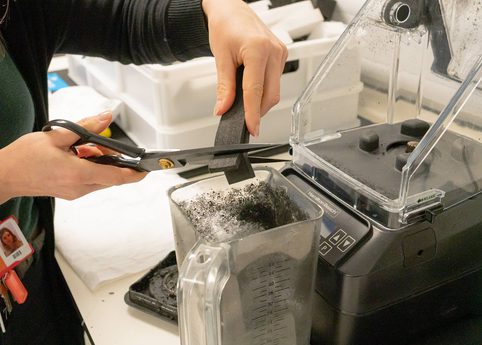
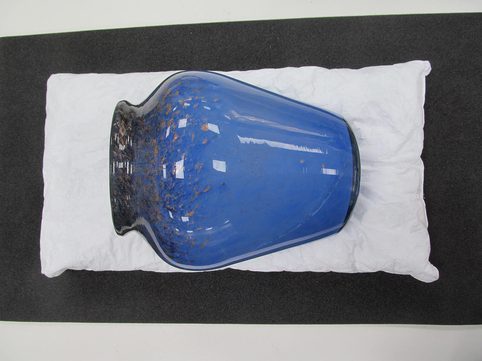
Use plastic-free packing tape
As well as reusing and recycling plastic packing materials, we’re also trying to find more sustainable plastic-free alternatives. At National Museums Scotland, we’re ‘Oddy testing’ more sustainable packing materials to find out if they’re safe to use with our collections.
We have found that both gummed and sticky paper-based adhesive tapes passed the Oddy test and are as effective as plastic tape for securing polythene packing. Similarly, at the National Galleries of Scotland, we have switched from plastic to paper-based tape, using suppliers such as Kite and RAJA.
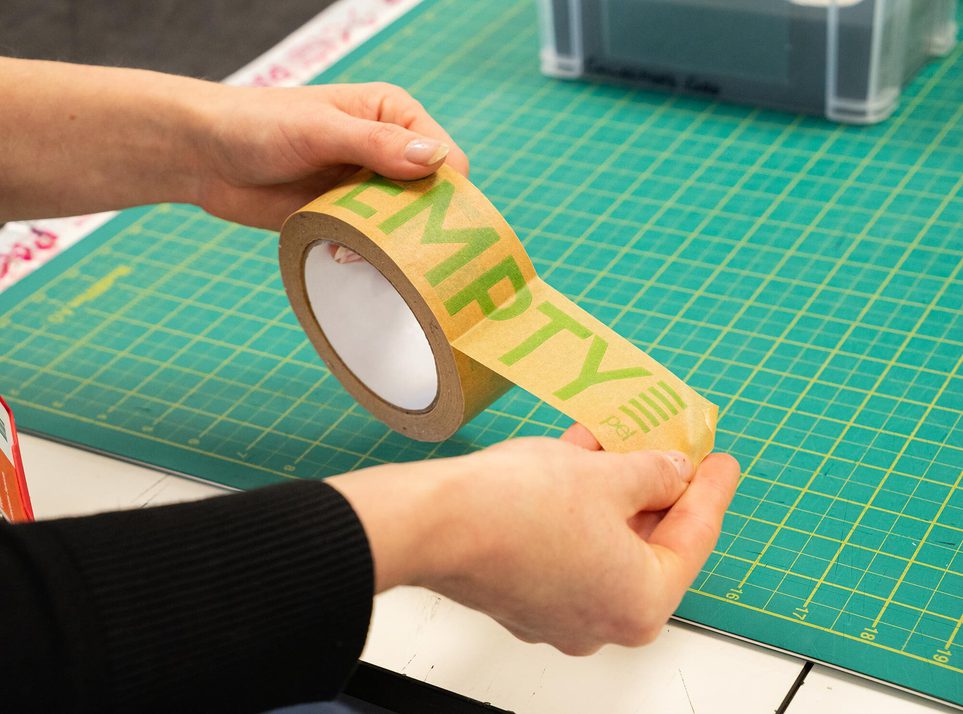
Use fabric covers
At National Museums Scotland, our textile conservators have been trialling the use of reusable fabric covers for boxes containing collection items. We cover boxes to provide an extra layer of protection when transporting for loans, moving between sites, or putting into quarantine (including into the freezer).
We have been working with a local sailmaker to design the covers and choose the best fabric. We went for an acrylic-coated canvas, an outdoor fabric used for boat products, which can withstand all sorts of weather and temperature.
Reusable covers reduces our reliance on polythene sheets and plastic tape. So far, our tests suggest the covers perform as well as polythene in the freezer. We’ll continue to monitor this.
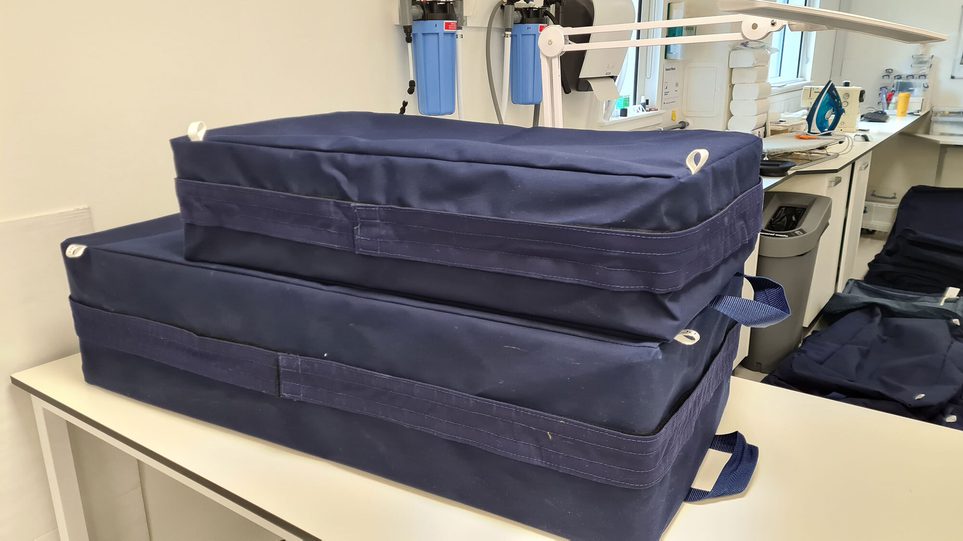
Get creative with object labels
At National Museums Scotland, we’re now using reusable polyester pockets and cards instead of disposable sticky labels for packing objects. This reduces waste and means any polythene sheeting we use is not covered in sticky labels. This makes it easier to recycle.

3. Clean green
At the National Galleries of Scotland, we have found that we already use a lot of sustainable approaches in our conservation cleaning.
Most of our cleaning involves dry dust removal with soft brushes and microfibre cloths, which we wash in warm water with a drop of mild detergent if needed. We occasionally use specialist waxes and cleaning products on our outdoor sculpture, but only apply tiny quantities once or twice a year.
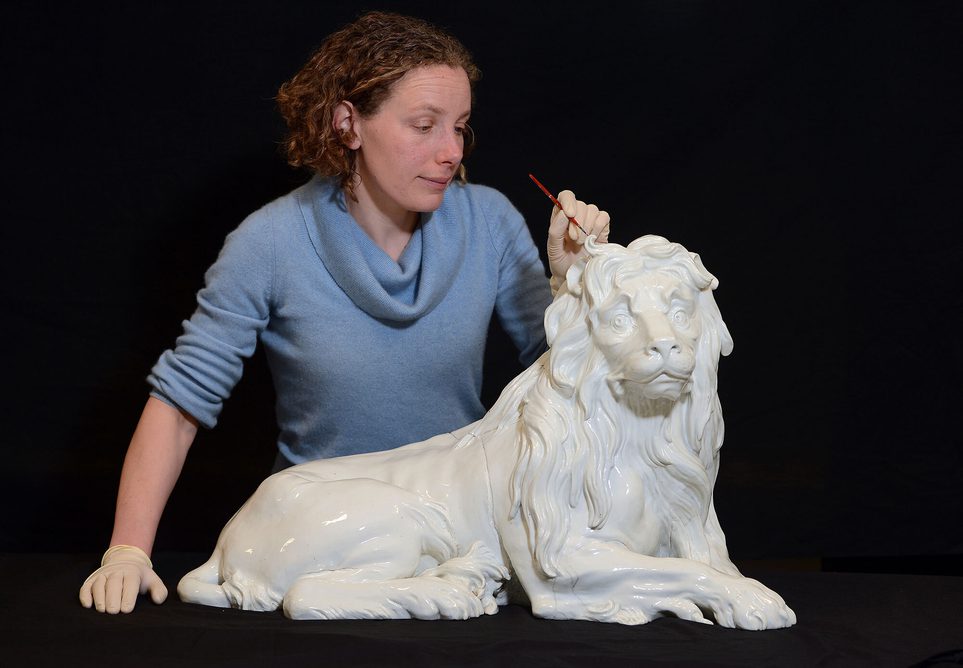
Use greener solvents
For conservation treatments, we’re thinking more about the materials we use. For treatments such as the removal of aged varnish and adhesives, we often use organic solvents derived from petrochemicals, like acetone and toluene. It’s not easy to find alternatives because solvents are chosen for very specific properties.
However, we’re testing some of the plant-derived greener solvents coming onto the market. Where possible, we’re also experimenting with aqueous treatments and gels, which are usually based on plant-based gelling agents such as agar.
At National Museums Scotland, we’re also experimenting with the ‘greener’ solvents and now regularly use heptane instead of white spirit in conservation treatments.
4. Control environments and pests
Controlling temperature and humidity and preventing pests can be a major source of energy consumption.
Risk-based environmental controls
At the National Galleries of Scotland, we’re gradually modifying our control strategies where we can, to use less energy. This includes taking a risk-based approach for environmental controls, with broader target bands to meet the requirements of the collection and the conditions it’s accustomed to.
We aim for well-maintained and insulated buildings. This enables us to keep the internal environment relatively stable, while allowing conditions to drift gradually over the course of the year, in harmony with the external conditions. This is known as ‘seasonal drift’. This thinking is set out in the refreshed Bizot Green Protocol, a set of international guidelines for more sustainable practices in caring for museum collections. The protocol was formally endorsed in 2023 by the first Museum COP.
Upgrading systems
At National Museums Scotland, we’re also focusing on building maintenance, including upgrading to more energy-efficient systems to control our environment. A lot of this has involved updating lighting to LED and installing additional thermal insulation and draught proofing in buildings across our sites.
We've also done significant work at National Museum of Flight to install air source heat pumps. This means the site is now entirely reliant on fully renewable sources, with space heating and electricity consumption at the site now at net zero.
Integrated pest management (IPM)
Our IPM policy at National Museums Scotland requires objects entering the collection to be taken to quarantine and frozen. This deals with any potential active infestations and is an important preventative measure.
However, our large walk-in freezer is energy intensive to run. We’re therefore now only using the freezer when we have a full load of material to freeze. This has reduced carbon emissions as well as helping to cut costs.

Similarly, at the National Galleries of Scotland, we manage the use of our chest freezer to keep emissions down. We also think carefully about the materials we use in our exhibitions. We avoid materials such as wool, which we know are attractive to insect pests, to prevent unnecessary use of energy and resources on IPM.
If we do have to tackle an infestation, we know that chemical pesticide treatments can contaminate the environment through residues and disposal. At National Museums Scotland we’re working to reduce our use of these pesticides, including trialling the use of parasitic wasps to deal with webbing clothes moths.
5. Greener transport options first
Lower carbon transport
At the National Galleries of Scotland, our principle for transporting collections is ‘greener options first’. This means asking for invoices from transport agents to include carbon emissions and looking at lower carbon transport options such as road, train or sea.
We’re also open to flexible timetabling. For example, where we can, extending the length of an exhibition to match up with other tours. This helps us, for example, to consolidate shipments and reduce the total transport emissions.
We follow a similar approach at National Museums Scotland. To help our decision-making, we track the carbon produced from transport and materials for all outgoing and incoming loans. We use a tracker we produced in-house, based on the UK Government Conversion Factors for greenhouse gas reporting.
Risk-based couriering
At National Museums Scotland and the National Galleries of Scotland, we only send a courier when we feel they’re required, for example to mitigate particular risks.
When using a courier at the National Galleries of Scotland, we always look first at options for:
- Virtual couriering
- Book-end couriering
- Sharing a courier with other organisations lending to the same exhibition
At National Museums Scotland, as part of our decision to send couriers for outgoing loans, we estimate and consider the associated carbon use. The number of couriers we send and the mode of transport for the collections is built into the contract.
We tend to use fewer virtual couriers due to the 3D nature of most of our collections. If we are sending a courier, it will often be to handle and install the objects, due to their fragility or specific handling requirements. As part of the organisation’s wider commitment to sustainability, we ask for sign off from the Director of Collections for any flights.
Reccommended resources
Groups and networks
Museums Galleries Scotland - Scottish Museums Climate Network
This network is on Microsoft Teams with channels dedicated to specific themes, including Collections Care. To join, email Museums Galleries Scotland’s Climate Officer at Climate@museumsgalleriesscotland.org.uk.
ICON (Institute of Conservation) Sustainability Group
This group encourages the take up of positive environmental practices in the conservation profession.
UK Museums and Heritage Sustainable Packing Group
Part of the EU-funded GoGreen project, this group aims to establish new sustainable standards for packing and transporting artworks. To find out more about the group and how to join, email Clare Richardson, Head of Conservation at The Courtauld.
Carbon calculating
Galleries Climate Coalition
An international community of arts organisations working to reduce our sector’s environmental impacts. Includes useful resources, including a carbon calculator.
STiCH (Sustainability Tools in Cultural Heritage)
A carbon calculator, plus case studies and information sheets, to help cultural heritage professionals lower the environmental impact of their work.
UK Government Conversion Factors
The government conversion factors are for use by UK and international organisations to report on certain greenhouse gas emissions.
Circular economy
CAN – Circular Arts Network
An online platform for sharing and redistributing art resources, materials, and equipment, embracing the principles of the circular economy.
Zero Waste Scotland
Scotland’s circular economy public body, providing support and guidance on making the most of the materials we have and reducing waste.
TerraCycle® Disposable Gloves - Zero Waste Box™
Recycling scheme for nitrile gloves.
Guidance
ICCROM Our Collections Matter Self-Assessment Tool
This tool helps you connect your collections work with the UN’s Sustainable Development Goals (SDG).
Ki Culture
An international nonprofit working to unify culture and sustainability. Includes guides on topics such as waste and materials.
Sustainability in Conservation
An online network providing resources and information about environmentally responsible practices in art conservation and related fields.
Greener Solvents in Conservation
A free online reference book for conservators looking to reduce their reliance on solvents derived from petrochemicals. You can also buy a hardcopy version at Archetype Publications.
Bizot Green Protocol
Guiding principles relating to climate controls, created by the international Bizot Group and endorsed in the UK by the National Museums Directors Council.